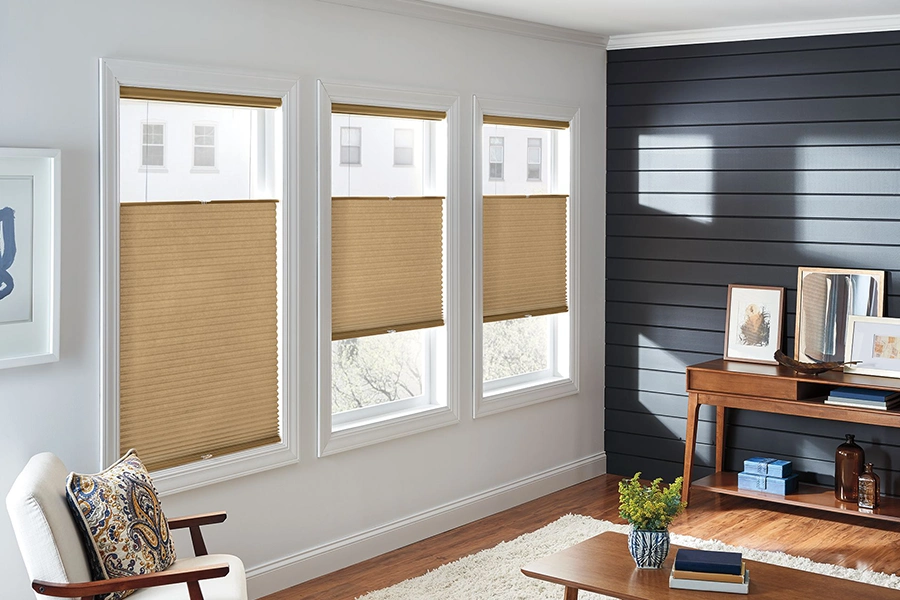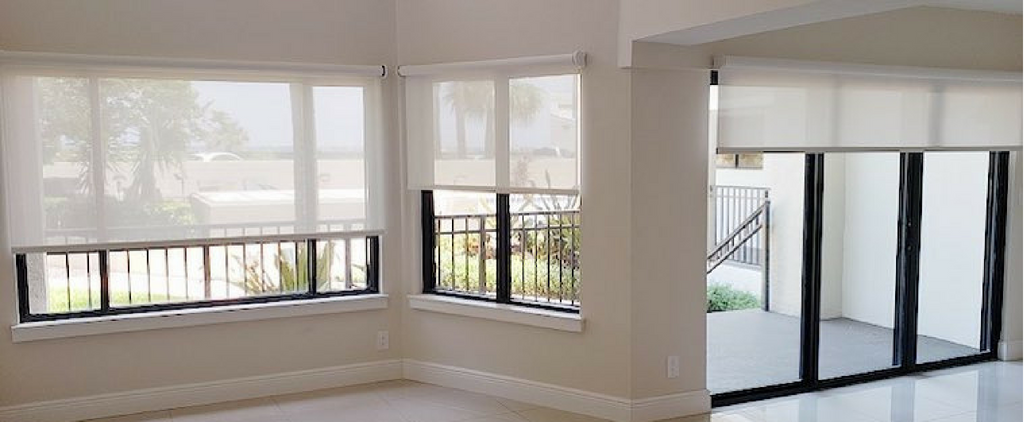The Ultimate Guide to Blinds: Types, Benefits, and Selecting the Right Suitable For You
The globe of home window treatments is vast and varied. Blinds are available in countless designs, each offering distinct benefits for different settings. Understanding these options is necessary for making informed decisions. Additionally, factors like material option and space functionality play a considerable duty. As one takes into consideration the excellent equilibrium in between aesthetic appeals and functionality, the nuances of measuring and maintaining blinds also become crucial elements. What should one prioritize when selecting the perfect window option?
Sorts of Blinds: A Detailed Summary
Blinds act as both practical and aesthetic elements in indoor style, providing various options to match diverse preferences and needs. Amongst one of the most popular types are Venetian blinds, characterized by straight slats that can be adjusted for light control and privacy. Roller blinds, known for their simpleness and adaptability, come in a variety of materials and patterns, making them appropriate for modern and conventional settings. Upright blinds, generally made use of for larger home windows or gliding doors, permit very easy modification and are frequently made from fabric or plastic.
Roman blinds, with their elegant folds up, add a touch of sophistication to any type of area, while cellular tones supply insulation and power effectiveness. Additionally, bamboo blinds use a natural, green option, instilling spaces with warmth. Each kind has unique functions and designs, ensuring house owners can find the ideal suitable for their specific decoration and useful requirements.
Benefits of Setting Up Blinds in your house
The installation of blinds in a home provides a number of substantial benefits. They provide improved personal privacy control, permitting homeowners to regulate exposure from the outside. In addition, blinds add to energy effectiveness by aiding to take care of indoor temperatures, minimizing the dependence on home heating and cooling down systems.
Enhanced Privacy Control
Mounting blinds supplies a significant advantage in privacy control when house owners seek to boost their living rooms. Blinds supply a functional remedy for managing exposure from both the inside and exterior of the home. By changing the slats or raising the blinds, individuals can easily take care of the amount of light entering while at the same time blocking the sight from outdoors. This flexibility permits house owners to produce a comfortable atmosphere without giving up all-natural light. Furthermore, different styles and products are readily available, making certain that house owners can choose options that seamlessly blend with their style while improving privacy. Ultimately, the installation of blinds works as an efficient means to guard individual space, urging leisure and assurance within the home setting.
Energy Efficiency Renovation
Setting up blinds not just improves privacy yet likewise considerably adds to energy performance in the home. By controling natural light and lowering warmth transfer, blinds can assist preserve a regular indoor temperature. Throughout warmer months, closing blinds can obstruct out extreme sunlight, therefore decreasing the reliance on air conditioning. On the other hand, in cooler months, they can give insulation by trapping warm, lowering heating costs. In addition, energy-efficient blinds, such as cellular shades, are designed especially to decrease energy loss. By buying top quality blinds, homeowners can produce a more comfy living environment while likewise reducing power bills. Ultimately, the installment of blinds works as a practical solution for those seeking to enhance both comfort and energy effectiveness in their homes.
Just how to Pick the Right Blinds for each and every Area
How can one determine the most appropriate blinds for each and every area in a home? The selection procedure starts with examining the space's objective and atmosphere. In living areas, functional blinds that allow light control while guaranteeing privacy are suitable. In bedrooms, blackout blinds can boost rest top quality by obstructing out external light.
Washrooms and cooking areas need moisture-resistant choices to withstand humidity, making vinyl or fake timber blinds appropriate choices. Furthermore, the desired visual plays a crucial role; coordinating blinds with the area's decor enhances the general ambiance.
Think about the amount of all-natural light each space gets; lighter blinds may be preferable for dark rooms, while darker options can include heat to sunlit spaces. Eventually, understanding details requirements and choices for capability and style will assist homeowners in making informed choices tailored to each space's special needs.
Material Options: Timber, Vinyl, Textile, and Much more

Timber Blinds Advantages
Timber blinds are a prominent selection among home owners seeking a blend of visual appeals and functionality. One substantial advantage of wood blinds is their all-natural charm, providing a warm and welcoming appearance that enhances any interior design. They are readily available in different coatings and colors, permitting for customization to match individual style. In addition, timber blinds offer excellent light control and personal privacy, as their slats can be quickly adapted to filter sunlight while keeping privacy. Their address durability is an additional benefit; with proper care, timber blinds can last for many years without shedding their allure (Phoenix window coverings). They have insulating residential or commercial properties, assisting to control indoor temperature levels and potentially lowering power expenses. Generally, wood blinds combine style and practicality, making them a perfect option for many houses
Plastic Longevity Features
Plastic blinds attract attention for their phenomenal durability, making them a useful choice for various settings. These blinds are immune to moisture, making them optimal for areas such as kitchens and restrooms where humidity can be a concern. Unlike timber, vinyl does not warp, split, or discolor under sunlight, making sure long-lasting performance and very little upkeep. Additionally, they are readily available in a variety of designs and shades, enabling property owners to tailor their appearance without sacrificing resilience. Plastic blinds are likewise simple to tidy; a straightforward wipe with a moist cloth is frequently enough to maintain them looking fresh. Overall, their resilience and low upkeep make vinyl a favored alternative among house owners looking for both capability and visual allure.

Material Alternatives Introduction
Blinds are available in a variety of textile alternatives that deal with different visual and practical demands. Common products consist of plastic, material, and wood, each offering one-of-a-kind advantages. Wood blinds offer a traditional, cozy visual and excellent insulation but require maintenance to stop bending. Plastic blinds are moisture-resistant and resilient, making them ideal for high-humidity areas like bathroom and kitchens. Fabric blinds, offered in numerous shades and patterns, use versatility and gentleness, boosting home decoration while supplying differing degrees of light filtering. Furthermore, alternatives like faux wood provide the look of natural wood with included toughness. When selecting blinds, it is vital to evaluate the certain requirements of each space to assure peak efficiency and design.
Measuring and Mounting Blinds: Tips for Success
Although measuring and installing blinds may seem simple, careful interest to detail is very important for accomplishing an excellent fit. First, it is necessary to determine the home window framework accurately, noting both the width and height. For inside places, deduct a percentage from the width to guarantee a tidy fit, while outdoors places need to prolong beyond the frame for better light control and visual appeals. Making use of a steel measuring tape is advised for accuracy.
When installing, collect all required tools, such as a degree, drill, and screws. Following the manufacturer's directions is important to assure appropriate setup. It is recommended to pre-drill holes to avoid damaging the braces. Additionally, having a second individual can make the process smoother, particularly when raising heavier blinds. After installment, examination the blinds to validate they run smoothly and change as necessary for optimum capability.
Maintenance and Treatment for Resilient Blinds
Correct maintenance and treatment can substantially extend the life expectancy of window treatments. Regular dusting is vital; using a soft towel or a microfiber duster can efficiently get rid of dust without damaging surfaces. For deeper cleansing, a gentle remedy of soap and water is recommended, used with a soft sponge, guaranteeing that no wetness permeates into the devices.
For fabric blinds, area cleansing is recommended, while wood blinds should be treated with a wood-safe cleaner to preserve their coating. Avoid subjecting callous excessive wetness, warmth, or direct sunlight, which can cause bending or fading.
Additionally, regular examination of cords and devices can stop damage. It's a good idea to comply with supplier guidelines for certain materials, as different blinds might have one-of-a-kind care demands. By taking on these simple maintenance methods, house owners can assure their blinds remain functional and visually pleasing for several years to come.
Frequently Asked Concerns
Can Blinds Help In Reducing Power Prices in My Home?
Blinds can properly reduce energy costs in a home by providing insulation, blocking heat during strip curtains summer, and keeping warmth in winter season. Their capability to manage light and air flow improves energy effectiveness throughout the year.
Are There Child-Safe Options for Blinds?
Yes, there are child-safe alternatives for blinds. These consist of cordless styles, retractable cables, and security devices that remove dangling cables, guaranteeing a protected environment for youngsters while preserving functionality and visual charm in homes.

Just How Do Blinds Contrast to Tones or curtains?
Blinds usually provide more specific light control and area effectiveness than shades or curtains. Phoenix motorized blinds. They are frequently easier to maintain and cleanse, while curtains give a softer aesthetic, and tones can use varying insulation advantages
Can I Personalize the Design And Color of My Blinds?
Yes, blinds can be customized in both design and color. Various suppliers provide a vast array of choices, permitting customers to choose materials, go now patterns, and shades that fit their personal aesthetic and home decor.
What Is the Ordinary Life-span of Various Sorts Of Blinds?
The ordinary life-span of blinds differs: wood blinds last 5-10 years, artificial timber 7-10 years, light weight aluminum 5-10 years, and fabric tones around 5 years, relying on use, exposure, and maintenance to sunshine.
Kitchens and restrooms need moisture-resistant choices to endure humidity, making vinyl or fake wood blinds appropriate options. Wood blinds provide natural elegance and warmth, while plastic supplies durability and ease of maintenance. One considerable advantage of timber blinds is their all-natural charm, offering a warm and welcoming look that boosts any indoor design. In addition, timber blinds give exceptional light control and privacy, as their slats can be conveniently changed to filter sunshine while preserving privacy. For textile blinds, spot cleaning is advisable, while wooden blinds should be treated with a wood-safe cleaner to keep their coating.